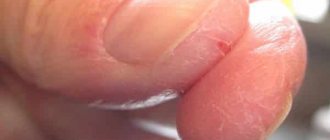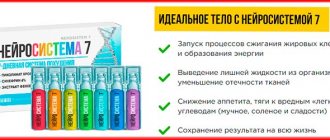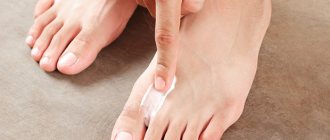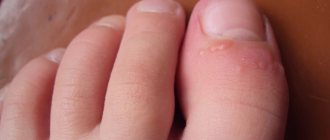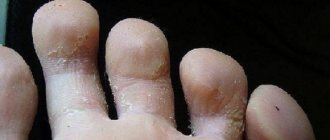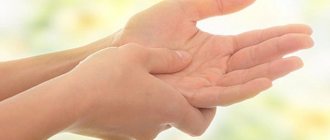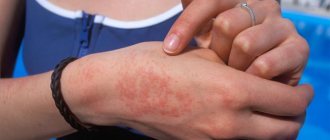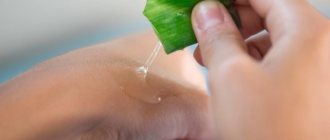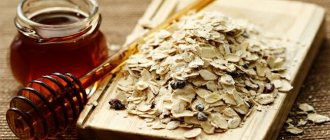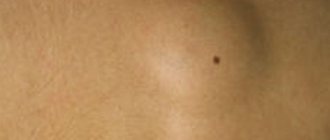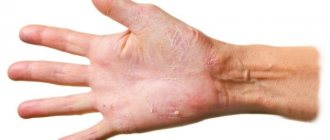What are corns?
Corns (dry calluses) are hardening of the surface layer of skin on the feet (accumulation of dead skin cells). Such formations develop due to repeated mechanical irritations and pressure on the skin of the feet. Constant rubbing leads to poor circulation in this area and increases keratinization of the skin. While walking, the corns remind you of themselves with a burning sensation and severe pain. Most often they form at the base of the toes and on the “pad”.
If corns appear periodically over a long period of time, you should consult an orthopedist. This may indicate the development of flat feet.
To avoid corns, you should carefully choose your shoes. It must be of high quality, fit exactly in size, be sure to have a comfortable last and not too thin soles. If the shoes are not comfortable enough, you often have to wear high heels or stilettos, you need to use special insoles or linings.
Statistics say that women have corns 10 times more often than men. These figures are due to the fact that ladies are willing to sacrifice comfort for the sake of beauty by wearing narrow shoes or high-heeled shoes.
Is it possible to get rid of corns?
According to experts, with the right approach it is possible to cure them. Although at home it will require a lot of patience and time. In a beauty salon, calluses are removed during a pedicure. It can be hardware or manual. In the first case, various nozzles are used, and as a result, the place of the corn is carefully sanded. A correctly performed procedure does not cause any painful sensations. For manual pedicure, special creams and tools are used instead of a machine.
At home, removing corns is also possible. First you need to take a half-hour foot bath. It can be with the addition of soda or sea salt. After this, treat the sore spot with pumice and apply a keratolytic agent. The choice of such drugs is large. You can try several different ones to find an effective remedy. In each case, it cannot be guaranteed that the cream that helped one person will immediately relieve another person from corns. Keratolytic agents contain the same active ingredients. Among them there is always salicylic acid, which has a disinfectant and anti-inflammatory effect, as well as plant extracts. They soften the skin.
Complete list of home remedies for corns
In addition to creams, keratolytic agents are presented in the form of a patch. It should be applied strictly to the corns, avoiding healthy skin. It is secured on top with a regular plaster for reliability. You can wear it on your foot for more than one day. Afterwards the procedure is repeated.
Natural remedies are quite effective. When used correctly, they are harmless but have many beneficial properties.
You can do the following compresses:
- Apply potato or onion pulp to the steamed legs and leave overnight;
- put on socks well soaked in vegetable oil and leave for several hours;
- Apply crushed celandine or cut aloe leaves to the corns at night;
Treatment of calluses between toes
Treatment of a callus between the toes consists of its mechanical removal, protecting its location from traumatic factors and eliminating the causes that caused excessive keratinization of the skin.
As a rule, ordinary water calluses are “reduced” independently at home.
To get rid of dry and callous calluses, you may need the help of a specialist.
In any case, before removing a callus, you need to make sure that it is really a callus and not a growth caused by a fungal or viral infection.
An interdigital callus on the feet can be confused, for example, with a plantar wart, and then its independent removal can lead to the spread of the virus and multiple relapses.
Patients with diabetes mellitus and disorders of the blood clotting system should approach the independent treatment of calluses between the toes with caution - it is better to entrust this matter to a cosmetologist with a medical education or a dermatologist.
Depending on the type of callus between the toes, their treatment will vary.
The essence of the procedures is always the same: to scrape off the keratinized growth using steaming or special means .
But the process of removing different types of calluses itself has nuances.
Soft callus between toes
Soft calluses between the toes appear in a matter of hours - just wear tight shoes, put shoes on bare feet or walk barefoot, and white blisters immediately rub on the skin.
This problem can be treated simply by removing the skin “film”.
Doctors do not advise piercing the water bladder, cutting off the thin skin with scissors or tearing it off, even if you really want to. It is better to wait until the soft callus between the fingers opens up on its own, the liquid flows out and the crust dries, then it can be easily removed by soaking it and rubbing it with a pumice stone.
What to do if a callus bursts - the answer is here.
If chafing has already appeared, to prevent dirt from entering and to protect against the pressure of shoes, you need to cover it with a band-aid. For this, a callus , a regular bactericidal or silicone patch in the form of a gasket is suitable, protecting the sore spot from contact with shoes.
To treat calluses and corns, we recommend using the COMPEED patch, which not only relieves pain and perfectly protects the skin from pressure and friction, but also creates optimal conditions for rapid skin restoration.
Dry callus between toes
Interdigital calluses on the feet most often appear in the form of soft, watery abrasions, but when systematically wearing unsuitable shoes, denser formations grow, representing a dry “plaque” , which with its cone-shaped top goes deep into the skin.
Favorite places for such calluses are the toes and the pads under them, closer to the outer edge of the foot.
As a rule, a dry callus between the toes causes severe pain when walking, from pressing to real “lumbago”.
Over time, the callus grows to such an extent that it can impair blood circulation in the foot, cause a change in gait, and deformation in the joints and spine due to involuntary incorrect positioning of the foot.
Once dry calluses have appeared, you can try to remove them at home.
To do this you will need “Salipod” or any other callus plaster.
These products are based on the action of salicylic acid, which softens and exfoliates dead skin from the surface of the growth.
After steaming the foot, a patch is applied to the dry callus, which must be worn without removing for two days. After 2 days, the patch must be carefully torn off. Part of the callus will come off with it. In this case, the skin is steamed and the rough skin is lightly rubbed with pumice.
Do not cut off layers of callus with scissors or a blade, otherwise you may get an infection. The procedure must be repeated until the corns are completely removed.
Instead of a patch, you can use a callus liquid with a keratolytic effect, which will slowly but surely remove the callus layer by layer.
In advanced cases, these remedies are useless . It is better not to delay and consult a specialist - a doctor or a pedicure office, where the callus will be removed quickly and effectively. For these purposes, modern hardware technologies are used, including laser therapy and cryodestruction of calluses. This is especially true for such growths that have a root inside.
Core (ingrowing) callus between the toes
Some dry calluses appear as a round lump with a small hole or point a few millimeters in diameter in the center.
If you remove the upper keratinized layers of skin, you can get to a single core of callus or several roots that look like thick white threads. Such growths are also called ingrown : the roots of the callus penetrate deeply into the skin and underlying tissues of the finger, so it is not easy to remove such a formation.
| Ingrown calluses between the toes are a problem that should be addressed by a doctor. | |
The root may even reach the nerve endings, so you should not try to remove it yourself . For this purpose, a cosmetologist has sterile instruments, equipment, and modern technologies.
The callus between the toes is removed in several steps. It is drilled out with a pedicure device, frozen with liquid nitrogen or cauterized with a laser. First, the upper keratinization “goes away,” then the root is removed, and new young skin remains in place of the growth.
You can also experiment with home treatment using pharmacy anti-corn remedies and folk recipes . But if after several procedures there is no improvement, then there is no point in continuing and it is better to leave your feet in the caring hands of professionals.
To speed up the healing process of various types of damage, including calluses, the “Keeper” balm is especially popular. High efficiency and rapid action, absence of unpleasant odor and safety of use are the main advantages of the drug.
Symptoms of corns
At the initial stage of corns development, redness and swelling of the foot appear. Further, it is a gray or yellow area of skin without clear boundaries, has a smooth or rough surface, on which cracks of varying depths are sometimes located. Corns can be either flat or convex in shape. In this area, the sensitivity of the skin to touch is reduced. Painful sensations usually appear while walking. The pain increases when the foot is inflamed or infected, or when deeper cracks form in the foot.
Sometimes corns are associated with enlargement of the big toe and its displacement in relation to the other toes. This puts more stress on the thumb and causes intermittent or constant aching pain.
The result of corns is soft tissue swelling and redness.
Rod form therapy
This type of callus is a hard, dense formation. It has a round shape and a deep root or rod in the center . Externally, this seal looks like a roughened area, which has a small depression in the center.
It is quite easy to get a core ingrown callus, but it is quite difficult to get rid of it. It’s easier to entrust this process to specialists in cosmetology clinics.
Removal methods
Drilling . When conducting a hardware manicure session, a special cutter of the appropriate size is used. Using this tool, the callus is carefully removed, while ensuring that the cutter does not injure the surrounding tissue and completely removes the core of the callus.
An incompletely removed rod can restore the callus. After completing the procedure, an antiseptic agent is placed into the recess that appears;
Laser removal . This method is used in advanced cases. The laser burns the rod, simultaneously destroying all bacteria. Due to this treatment, the possibility of developing an inflammatory process is completely excluded;
Cryotherapy . This method is very effective. With its help, the callus is completely removed. The method is based on treating the damaged area with liquid nitrogen, after which the keratinized skin quickly peels off.
It is quite difficult to cope with callus using folk remedies, as they are fast-acting. Now you know how to remove calluses between your fingers so that there are no big problems.
It is not recommended to independently eliminate calluses using mechanical methods without steaming your feet. Therefore, carefully study our article to know how to remove a callus between your toes; our video will help you with this.
If left untreated, the callus will become more painful over time. Microcracks will begin to appear on the keratinized area of the skin, and this is fraught with infection and the development of an inflammatory process.
Causes of corns
Tight shoes
Most often, corns occur due to the wrong choice of shoes. Tight, with high heels or with hard insoles, it increases the load on the feet. Wearing it leads to poor circulation and thickening of the skin in certain areas. Over time, corns form there. This cause is more common among women than among men. Girls prefer narrow high-heeled or stiletto shoes. The weight in such shoes is distributed unevenly and leads to the appearance of dry calluses.
Stress and fungal diseases
Corns on the soles of the feet are a common occurrence for people with diabetes and those who are overweight, which puts a lot of stress on the feet. Another cause of dry calluses is frequent nervous disorders. Although at first glance it is difficult to see the connection between corns and stress. Metabolic disorders and fungal diseases also contribute to the formation of dry calluses.
Disruption of internal organs
Scientists have concluded that corns appear on certain areas of the foot not by chance. This indicates the presence of a particular disease. A dry callus under the little toe on the right foot may indicate a disruption in the normal functioning of the liver; on the left, it may indicate problems with the cardiovascular system. It is worth contacting an endocrinologist if corns appear on your thumbs. This may be due to thyroid disease. Dry calluses on the heels indicate problems with the intestines or joints.
If the cause of the appearance of corns on the feet is a disease of other organs or systems of the body, you need to consult a doctor. He will select the necessary treatment. In such cases, remedies for dry calluses are ineffective. After all, these are only external manifestations of health problems that need to be solved. By eliminating the cause, it will be possible to get rid of the effect - corns.
Other reasons
- Excess weight, poor circulation in the legs, and excessive sweating of the feet can also lead to the appearance of corns.
- Changes in the shape of the foot (eg, flat feet, deformities of the leg bones, bone spurs on the joints) cause pressure to be distributed unevenly. In those places of the foot where the pressure is maximum, corns appear.
- In addition, the risk of developing corns increases in people with rheumatoid arthritis or nerve diseases.
- Calluses often plague runners and ballerinas.
With proper prevention, their occurrence can be avoided. It is enough to choose quality shoes and rest on time. It is important to watch your figure: excess weight creates additional stress on your legs. It is also recommended to periodically make softening foot baths and smear them with moisturizer.
Preventing calluses between the toes
As you know, the best medicine is prevention. If you are constantly plagued by interdigital calluses in one place or another, it is useless to carry out treatment without eliminating the provoking factors of the skin’s protective reaction.
It is recommended to follow the following recommendations:
- Choose the “right” shoes: the right size, with a comfortable last, stable heel, comfortable height, normal fullness. Leave narrow toes and extreme heels for rare special occasions, but for everyday wear, shoes should not cause any discomfort. High-quality shoes are the key to healthy feet.
- Let your feet rest and “breathe” more often: at the first opportunity, take off your street shoes and change into lighter and more comfortable ones.
- Protect your feet from pressure and friction from shoes if they are still poorly worn. Use special products: stretching sprays, protective gel and silicone pads that are glued to areas of painful contact and calluses.
- Don't forget about proper care of your shoes and hosiery. Feet should always be kept clean and dry. Buy high-quality socks, made from natural materials, that fit your feet well and provide good air exchange.
- Take care of the skin of your feet regularly. Dry the skin between your toes thoroughly after washing your feet. Use softening creams, scrubs, foot baths, massage.
- Do not forget about measures to prevent fungal diseases. Fight excessive sweating of your feet.
- The best prevention of calluses and corns is regular pedicure procedures. Please note that the pedicure should not be classic (edged), but hardware. It is safer, more hygienic and effective. During the procedure, the master not only treats the nails and fingers, but also polishes the heels, pads on and between the toes, and removes rough skin.
- Take care of your health: get rid of excess weight, consult an orthopedist. Perhaps your calluses are caused by flat feet, and your doctor will recommend that you wear special anatomical insoles.
An excellent tool for the prevention and treatment of wet calluses is the COMPEED pencil.
It is colorless and invisible on the skin, does not smell, copes well with existing wounds and prevents the appearance of new ones. Take care of your feet, and very soon you will forget about such a nuisance as calluses between your toes.
Corns on the sole with a rod
Such calluses are rough areas of skin with a deeply penetrating root. It is called the rod. Because of it, corns become a source of pain when moving. There is a cap on top of the rod. As the disease progresses, it increases in size. Therefore, one should not delay his treatment. Corns with a core are of two types, depending on the causes of their occurrence.
In the first case, they, just like ordinary dry calluses, appear due to constant exposure to an area of skin. In women, they occur in the soft part of the foot under the toes. The reason for this is tight high-heeled shoes. Runners often suffer from calluses caused by regular exercise. Therefore, it is necessary to practice in special shoes.
The cause of the second type of dry calluses with a core is a virus. In this case, you need to fight not only its external signs on the skin, but also take appropriate antimicrobial drugs.
Unlike ordinary calluses, corns with a core are more difficult to treat. This is due to the presence of a deep root. You can deal with them on your own, but not in advanced cases. When the rod has penetrated deep enough, it is better to contact a specialist. Removal of such a callus must be carried out in a hospital, as sterility must be carefully maintained. Otherwise, when contracting an infection, various complications are possible. In addition, only a doctor, using special tools, will remove the corns without leaving a core. With superficial treatment, dry callus will appear on the affected area of the skin again.
Home remedies are good when the corn has a shallow core.
On the topic: how to quickly get rid of corns?
There are several effective recipes:
- keep your feet in a soda-soap or mustard solution. When the skin has steamed, carefully remove the cap and root. This is often not possible to do the first time, so a course of procedures is carried out. After baths, use a cream with an oily texture to moisturize;
- As for the treatment of ordinary corns, onion compresses are suitable. You need to stick a patch on top of the slurry;
- Prunes boiled in milk can be applied to the affected area of the skin. It must be hot;
- a compress of garlic and lard at night does not have a very pleasant smell, but it helps well with corns with a stem;
- You can apply a crust of black bread soaked in vinegar essence.
However, if long-term treatment with folk remedies does not help, you should urgently consult a doctor. Keratolytic agents, patches, compresses, baths - all this refers to superficial treatment and does not eliminate deep-rooted corns. Especially if these are old calluses. In the case of them, it is necessary to remove them in a clinic.
How to remove dry callus
You can get rid of internal dry or rod-shaped callus using conservative treatment methods, traditional medicine or hardware procedures.
Be sure to read:
Is treatment necessary for molluscum contagiosum in children?
Creams
The use of special creams is a conservative method of treatment. With the help of such drugs you can get rid of both internal and rod-shaped calluses. It is best to use these tools:
- Evo cream with urea. Apply to the problem area of the skin in the morning or evening until the problem is completely eliminated.
- Not a callus. Apply the patch to the callus, first cutting a hole the size of the growth in its center. The problem area is smeared with cream and sealed on top with a second patch for 2 days.
- Super-Antimozolin. Apply the cream to the problem area, cover with wax paper and put on socks. After two hours, rinse with warm water, removing the softened skin of the growth. Use daily until the problem is completely removed.
Treatment of corns
When a corn appears, the first step is to eliminate the traumatic factor that contributed to its appearance: give up tight and hard shoes, hard insoles, heels, and switch to looser boots and shoes.
If corns are a result of deformation of the leg bones or flat feet, you should consult an orthopedist. The doctor will give advice on correcting flat feet and help with the selection of special shoes and insoles.
The next step is to eliminate the corn itself. In order for the skin to perform its functions, it is necessary to get rid of the stratum corneum. A keratolytic cream will help remove it. It is applied to the area with keratinized skin, covered with a band-aid and left overnight. In the morning, when the skin softens, the corns are treated with pumice. As a rule, after several procedures the problem disappears.
Callus patches can be used to treat corns. Their surface contains the necessary medicinal components.
If you need to relieve pain and inflammation, you can use medications (aspirin, naproxen, ibuprofen) or simply apply a cold compress.
Never cut off corns, especially if you have circulatory problems. In some cases, surgical methods are used to remove corns. After the operation, special shoes are selected and physical activity is limited. Such measures reinforce the success of the surgical procedure.
An x-ray examination of the leg will not be superfluous. The image will help check the integrity of the joints of the legs and find out if there are other diseases such as gout or arthritis.
Among the modern methods of treating corns are:
- Keratolytic agents: features, composition
- Plasters for corns
- Special pencils for corns
- Japanese Baby Foot socks
- Hardware pedicure
- Cryodestruction
- Laser therapy
- Pads against corns
Preventive measures
If the appearance of calluses between your fingers has become a common occurrence, then it’s time to pay attention to preventive measures:
- Reconsider your shoes. Dress shoes with a narrow, uncomfortable last that squeeze the foot and toes should be worn as rarely as possible. The same goes for high heels. For constant wear, it is better to choose shoes and boots that are well-suited in size, in which the toes will be positioned freely.
- You should not put new shoes on your bare feet. Most often, it is in such cases that skin lesions form. First, shoes should be broken in using special spacers or sprays and protecting the skin of the feet with a patch or soft gel pads.
- Socks and tights should be changed regularly and these wardrobe items should be selected, giving preference to breathable natural materials.
- Excessive fatness increases the load on the feet, so to prevent the appearance of calluses, you should get rid of excess weight.
- It would be useful to be examined by an orthopedist for the presence of curvature of the fingers, flat feet and to select corrective devices.
- It is necessary to promptly treat diseases accompanied by the appearance of severe swelling of the legs, as well as joint diseases.
- Moist skin in the interdigital space is most susceptible to the formation of abrasions and dry plaques. Foot baths with the addition of oak bark or sage leaves should be used to reduce excessive sweating of the feet. After hygiene procedures, you need to thoroughly dry the space between your fingers. For the same reasons, it is not advisable to wear shoes on bare feet in rainy weather.
- Foot hygiene should come first. Regular pedicures, protection and treatment of toes from fungal infections, foot care with softening and moisturizing creams or gels will keep the skin of the feet soft and smooth, preventing the formation of abrasions and calluses.
Video material on hardware pedicure:
If it was not possible to prevent the appearance of dry formations, you should not delay their removal. These calluses can grow and become more difficult to remove.
Callus between the toes is a problem that occurs very often among people. It is invisible to others, but the pain it sometimes causes can be unbearable.
There are many ways to treat calluses between your toes and get rid of this inconvenience, but the best option is to prevent the formation of calluses .
Laser removal of corns
To get rid of corns in medicine today the following is used:
- drilling;
- cryotherapy;
- laser therapy.
Drilling
In the first case, treatment is carried out by a cosmetologist. In this case, a device with various drills is used. This method is suitable for calluses without a stem. The area of skin with it is treated twice with a bur of larger and then smaller diameter. There should be no blood. The procedure is usually painless. In advanced cases, a course of baths is carried out first.
Cryotherapy
Cryotherapy involves removing corns using liquid nitrogen. It is used when calluses are advanced or have a deep core. As part of cryotherapy, the affected area of the skin is treated with liquid nitrogen, which is odorless and colorless. After a few days, the seal in the form of a corn will disappear. This treatment method is painful and may cause discomfort. There is a risk of affecting healthy skin near the corn or causing an infection after treatment with liquid nitrogen, so you should be careful about caring for your feet after the procedure.
Laser removal of corns
Laser removal of dry calluses is the most effective and painless method. Among its main advantages it is worth noting:
- absence of blood during the procedure;
- the duration of treatment is only a few minutes;
- thanks to local anesthesia there is no pain;
- one treatment session is enough to solve the problem;
- After the procedure, you can stand on your entire foot and move actively.
Some time after laser therapy, new healthy skin will appear at the site of the diseased area. If the callus has a core, then as a result of the procedure it will be completely removed. If you follow all the doctor's recommendations and carry out prevention, the corns will no longer appear in this place. You will need to wear a special bandage and use a special insole for several weeks. This will avoid complications and pressure on the corns.
Although laser therapy is not the cheapest way to get rid of dry calluses. But one procedure is enough for a positive effect, so you shouldn’t skimp on your health.
Laser treatment is harmless and leaves no traces. The beam simply destroys dead skin cells at the site of the corn. Moreover, it does not affect healthy tissue around. In addition, rapid recovery after laser therapy eliminates the possibility of complications or infection.
Treatment with this method has contraindications. It is not suitable for people suffering from diabetes or cancer. It should not be used if there are wounds or damage to the skin.
You need to contact a podiatrist at the clinic. He can carry out laser treatment and give appropriate recommendations on how to avoid corns in the future. It is also worth consulting with an orthopedist. Dry calluses can be a consequence of problems with the musculoskeletal system.
In conclusion, it is worth noting that corns form very often. If you notice their appearance in time, you can deal with them yourself. The main thing is to choose high-quality shoes for constant wear and special ones for sports. But the treatment of advanced calluses should be entrusted to specialists in order to get rid of them for a long time and not get complications. The procedure, performed by a professional, is painless, does not take much time, and is the most effective way to solve the problem of corns.
Types of calluses
Most often, wet calluses appear on the skin of the fingers as a result of friction. This is an injured area covered with thin white skin that peels off from the surface. There is lymphatic fluid inside the wet callus, so the formation rises above the skin like a bubble. It is prone to bursting and weeping, so it can become a cause for secondary bacterial infection.
If risk factors act on the same area of skin constantly, other types of formations form on it:
- Dry calluses, or corns. This is a hard, rough area of skin that may hurt when pressed. The deeper the area of epidermal damage, the more unpleasant symptoms it provokes.
- Calluses with a core. Typically, such a corn is cone-shaped or round in appearance. Inside the core callus, a root (rod) is visible - a hole that goes into the deep tissues of the limb. It is quite difficult to cure such a callus.
If you can remove a wet callus at home quickly and easily, then it is better to remove root and other dry formations under the supervision of a specialist. The sooner therapy is started, the less likely it is that the corn will grow into the muscle and compress the nerve fibers.
Little toe hurts: diagnosis
It is almost impossible to recognize the disease based on the symptom complex: many manifestations overlap, others develop in later stages.
Therefore, you should not try to diagnose yourself; it is a futile exercise and a waste of precious time. At the first signs of discomfort, you should consult a doctor. The first person it is recommended to visit is your local therapist. Instead of a therapist, you can visit a surgeon. These doctors will conduct an initial examination and help develop a further “plan” of action. In the future, diagnosis and treatment should be carried out by a specialized specialist:
Orthopedist - if the source of the problem lies in pathologies of the musculoskeletal system.
Traumatologist - when the little finger is injured.
Rheumatologist - together with an orthopedist, helps to cope with the root cause of rheumatoid arthritis.
Nephrologist - if the reason is a lack of functioning of the excretory system (in particular the kidneys).
Endocrinologist - if diabetes is suspected.
Phlebologist - specializes in problems with blood vessels.
The little toe hurts: what are the reasons?
For the most part, the reasons are very “prosaic”, but we can also talk about serious pathological processes.
In the vast majority of cases, the problem lies in disorders of the musculoskeletal system of the foot. What problems can we talk about if the little toe hurts: Inflammation of the nail fold due to an ingrown toenail
. This problem most often affects the thumb, but due to anatomical features it can also affect the little fingers. An ingrown toenail can cause an infection or fungal infection.
Corn
. It is a traumatic keratinization of the skin in places of constant friction or pressure. The little finger is the most common location for calluses. An uncomfortable sock or tight shoes can all cause blisters.
Fungal infection of the little finger
. Fungal infections are manifested not only by pain, but also by itching, burning, inflammation and redness of the skin of the finger. In some cases, deformation of the nail occurs.
The three indicated problems account for up to 50% (according to medical statistics) of all causes of discomfort in the little toes. Other diseases are less common:
Arthritis
. Arthritis is an inflammatory disease of the joints. It is endogenous in nature: if arthritis is detected, the reasons for this should be sought in the excretory or endocrine systems. In some cases, the source of the disease is an immune reaction, then they talk about rheumatoid arthritis. It occurs with sluggish symptoms at the initial stage. When the intensity of symptoms increases, diagnostics reveals a mature process, the treatment of which is much more difficult.
Arthrosis
. Unlike arthritis, osteoarthritis is caused by external circumstances. In older people, arthrosis becomes a kind of age-related norm: the disease does not always proceed aggressively. In young people, such pathology is rare. These are mainly young women (due to wearing narrow, uncomfortable shoes) and people of both sexes engaged in heavy physical labor: athletes, builders, loaders, etc.
Gout
. It occurs mainly in men. This is a systemic disease caused by the deposition of urate salts in the joint cavities. The joints of the thumbs are mainly affected, but the little fingers also do not remain outside the pathological process.
Inflammatory lesions of the anatomical structures of the finger
. These include tendonitis (inflammation of the tendons) and bursitis (inflammation of the joint capsule). They develop as a result of prolonged monotonous strain on the foot, or with a single intense strain, also as a result of hypothermia. Pain during inflammatory processes is much more intense, without clear localization. Unpleasant sensations spread throughout the entire foot and intensify when walking.
Osteomyelitis
. Necrotic lesion of bone tissue. It is rare, but it is extremely difficult: symptoms of intoxication of the body are observed, the process is expansive, quickly covering not only the bone, but also the surrounding tissues. With a weak immune system, the cause of this dangerous disease can be a banal cut or the presence of a chronic source of infection in the body (cavities, etc.).
Neuroma
. Overgrowth of nerve tissue located in the foot. Pain with neuroma is diffuse, spreading to the entire foot. Favorite places to localize unpleasant sensations are the thumb and little finger. It does not pose a danger to life, however, it is difficult to tolerate.
Injuries
. Obviously, any injury can cause pain in the little toe: from a bruise to a fracture.
Deformations
. If the foot is in an uncomfortable position for a long time as a result of wearing poor-quality shoes or incorrectly positioning the foot, deformations of the little toe are possible.
Problems with blood vessels of the lower extremities
. Stenosis of the vessels of the lower extremities leads to a lack of nutrition of the underlying structures, including nervous tissue, which reacts acutely to any changes in blood supply. Atherosclerosis occurs in long-term smokers, obese individuals, patients with hepatitis, cirrhosis, etc.
Diabetes
. As a result of diabetes, systemic damage to the structures of the foot develops - the so-called. diabetic foot.
